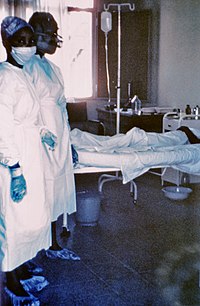
Photo from wikipedia
Background There are limited data regarding the long-term health effects of child survivors of the 2013-2016 West African Ebola virus disease (EVD) outbreak. Here, we assess post-Ebola sequelae among EVD… Click to show full abstract
Background There are limited data regarding the long-term health effects of child survivors of the 2013-2016 West African Ebola virus disease (EVD) outbreak. Here, we assess post-Ebola sequelae among EVD child survivors by comparing the self-reported symptoms between EVD child survivors and their close household contacts over one year after the end of the outbreak. Methods EVD child survivors(n=159) and their close contacts(n=303) were enrolled in Western and Eastern Sierra Leone. Demographics and self-reported symptoms data were collected using an interviewer-administered questionnaire. We compared a list of self-reported symptoms between EVD child survivors and their close household contacts using backward stepwise logistic regression. Results EVD child survivors were more likely to be orphans compared to their close contacts. Musculoskeletal, ocular, auditory and neurological symptoms were more prevalent among Ebola child survivors than their close contacts (p<0.001). Joint pain and headache were the most common self-reported symptoms in EVD child survivors and their close contacts. Joint pain (AOR=2.633; 95 % CI:1.31-5.28, p=0.006), eye pain (AOR=4.56;95 %CI: 2.16-9.64, p<0.001), hearing loss (AOR=3.85; 95 %CI: 1.15-12.87, p=0.029), memory impairment (AOR=7.76;0.95 %CI: 1.34-45.01 p=0.022), mood changes (AOR=5.07; 95 %CI: 2.35-10.94, p<0.001) were more common among survivors than their contacts. Conclusions Our data suggest that EVD child survivors have higher odds than their close contacts of suffering from musculoskeletal, ophthalmic, auditory and neurological impairment more than a year after the end of the EVD outbreak. Routine screening, treatment and monitoring of these symptoms is required to prevent long-term disability among EVD child survivors.
Journal Title: BMC Pediatrics
Year Published: 2021
Link to full text (if available)
Share on Social Media: Sign Up to like & get
recommendations!